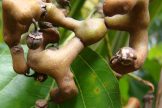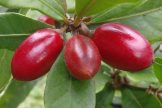
 Important note about plant availability. Important note about plant availability.There are hundreds of factsheets on our website provided for your information. Not all plants will be available at all times throughout the year. To confirm availability please call (03) 8850 3030 and ask for the nursery. |
Guava (Chilean)
Myrtus ugni (synonyms: Ugni molinae, Eugenia ugni)
A dainty bush with small glossy green leaves, perfect for hedging. Fruits well in partial shade as well as sun. Abundant small white self-fertile flowers appear in early summer, quickly followed by red berries, which remain small and deep red for 4-5 weeks before swelling and becoming paler, at which point they are ready to pick, reaching around 1cm in size. They can be eaten fresh off the bush as berries do not keep for long. Will store in the fridge for 5 days. Chilean guava berries have a flavour that is intense, variously described as sherbet-like, piquant, sweet-sour, kiwi, strawberry and something a little spicier, almost like bubble-gum. The concentrated flavour means you only eat a few at a time. Try adding to muffins or friands, use instead of cranberries for a sauce, or scatter through a summer pudding.
Guava (Strawberry)
Psidium littorale (prev P.cattleianum)
There are red and yellow varieties of this guava. Red strawberry guava, red cherry guava, red cattley guava
An evergreen small tree suitable for hedging and growing in containers. Grows in full sun as well as part shade. Often grown purely as an ornamental tree, this extremely loveable claret-red fruit is the best of the guavas. Although slow to start off, this tree will eventually provide you with a couple of punnets every week over a 2-3 month period, between April and June. Free of the muskiness of the common guava, the flavour is somewhat strawberry-like, spicy, sub-acidic and the scent is faintly spicy orange. The seeds are small and hard, but can be swallowed whole. When cooked the seeds need to be sieved out. Usually eaten fresh, juiced or made into a jam. The fruit is also high in Vitamin C.
Strawberry guavas are frost tolerant to -5°C once mature (protect young trees) and not at all fussy about their growing position, tolerating dry conditions and even part-shade. They make a fantastic screening shrub or small feature tree with attractive caramel coloured bark and fluffy red and white flowers. They flower and fruit on new growth so pruning the previous season’s stems will encourage a better crop the following year. Harvest begins in April, and goes through until June. Best picked when fully ripe. The fruit is round, 2-3 cm in diameter (the size of a small plum), deep wine-red, with a very thin skin. Self-fertile.
Yellow strawberry guava, yellow cherry guava, lemon guava, yellow cattley guava There is also a yellow variety which has larger, sweeter and milder fruit, and it’s probably the sweetest and mildest of all guavas. The fruit are 3-4cm in diameter, yellow skinned with a sweet, aromatic, creamy white flesh and small seeds.
The yellow cherry guava trees with their lighter coloured and duller leaves are less attractive than the red varieties, but they are more prolific bearers of fruit. Not as hardy as the red variety.
Flowers are cup-shaped, fragrant and pink (to 3.5cm across), blooming in spring, followed by yellow oval fruit which ripen in late autumn with an intensely sweet fragrant aroma. Fruits are edible off the tree or may be stewed or used in jams and syrups.
Guava – Brazilian
Psidium guineense
A small subtropical tree 1-3m tall which can be pruned to size. Frost sensitive. Produces round or pear-shaped fruit similar in size and appearance to the common guava, with yellow skin and pale-yellow flesh surrounding a white acidic pulp. These guavas have an excellent guava-strawberry flavour with a sweet-sour fruity taste, sometimes described as tasting like pineapple jam. They don’t have the strong aromatic smell and taste of other guavas which some people dislike. The fruit contains small seeds which are make them easy to eat. The fruit may be eaten fresh, or used to make jellies and preserves.
Indian Guava
Psidium guajava
A tropical/subtropical guava tree growing to 4m that is also suitable for growing in pots and containers. White flowers in summer are followed by yellow skinned juicy sweet small to medium sized fruits with a white firm flesh containing seeds. Fruits are edible off the tree or can be used in jams, juices, jellies and desserts. Grows well in full sun to part shade in rich, well-drained soil in a protected area. Drought and frost tender.
Guava – Mexican Cream
Psidium guajava
An upright growing tropical/subtropical guava tree growing 2-5m high, which can be pruned to maintain a height of 2m, suitable for grown in pots. Frost tender. Produces small to medium sized roundish fruit around 5cm in diameter, with a pale yellow skin, sometimes with a slight red blush. The flesh of the fruit is creamy, white, thick, fine-textured, very sweet and aromatic, with an aroma of pineapple and passion fruit, excellent for desserts. The fruit has a small seed cavity small with fairly soft seeds
Guava – Hawaiian
Psidium guajava
An attractive spreading tropical/subtropical guava tree growing to 2-5 metres that can be pruned to keep compact, also suitable for growing in pots and containers. Takes four years to bear fruit. Requires protection from frosts. Prolific cropper producing large, yellow skinned fruit with pink flesh which can be eaten fresh, juiced, used in jams and jellies.
Guava – Thai White
Psidium guajava
A tropical/subtropical guava tree which can be pruned to size, suitable for growing in a pot, will fruit in a small sized pot. Frost sensitive. Produces large, green-skinned fruit containing few seeds, sweet creamy white flesh with mild flavour, can be eaten crunchy or soft, all parts of the fruit are edible, including the skin and seeds. Requires protection from frosts.
Guava – China Pear
Psidium guajava
A tropical/subtropical guava tree growing 2-4m high which can be pruned to size. Frost sensitive. Produces large, pear-shaped fruit with light yellow skin and thick, creamy and very sweet, finely-textured white flesh. Requires protection from frosts.





